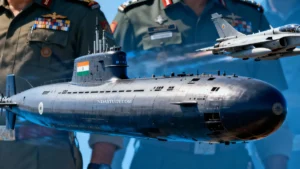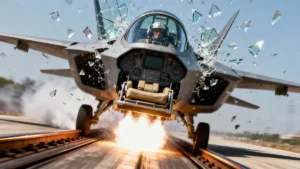Did you know that India’s defence budget has skyrocketed to an astonishing ₹6.81 lakh crore (about $78 billion) for the year 2025–26, which is a 9.5% increase from last year. This budget now makes up almost 2% (1.91%) of the country’s GDP. If this trend continues, experts say India’s defence budget could grow to over ₹13 lakh crore by 2030, making it one of the top three military spenders in the world. For NDA aspirants and young people in India, this means more job opportunities, access to modern technology, and the chance to build a stronger, self-reliant nation.
As security challenges increase and the landscape of modern warfare evolves, India acknowledges the urgent need to modernise its military capabilities. A substantial portion of the defence budget is being allocated to domestic manufacturing, in support of the “Atmanirbhar Bharat” (Self-Reliant India) initiative. This investment marks a crucial turning point for India, as it aspires to become a major defence power in Asia and beyond, while also bolstering its domestic economy. Why experts say the Defence Budget Is Set to double by 2030?
Growth Behind India’s Military Spending
India is significantly increasing its defence budget. This change shows the country’s rising goals and the security challenges it faces. Let’s examine the numbers, compare them to other global powers, and see how the money is being spent.
India’s Defence Budget 2025: Breaking Records
- For 2025-26, India has allocated ₹6.81 lakh crore (about $78.3 billion) to defence—a record high and a 9.5% jump from last year’s ₹6.22 lakh crore ($75 billion).
- This budget is the highest among all Indian ministries, making up 13.45% of the total Union Budget.
- The increase is driven by a push for modernisation, heightened border tensions, and a strong focus on making India self-reliant in defence manufacturing.
Also Read: Defence Budget 2025: How India’s Military Spending Shapes National Security
Why experts say the Defence Budget Is Set to double by 2030?
| Year | Defence Budget (₹ Crore) | % of GDP | Key Focus |
|---|---|---|---|
| 2022 | 5,25,000 | 2.0 | Modernisation, Salaries |
| 2023 | 5,94,000 | 1.97 | Indigenisation, Tech |
| 2024 | 6,22,000 | 1.9 | Local Procurement |
| 2025 | 6,81,210 | 1.9 | Modernisation, R&D |
| 2030* | ~13,00,000 (Projected) | ~2.0 | Exports, Advanced Tech |
**Disclaimer: Some data in the table is based on analysis by NDA Study experts; therefore, the data presented is merely an assumption derived from years of trends and analysis.
Where Does the Money Go?
- Capital Outlay (Modernisation & New Equipment): ₹1.8 lakh crore (26% of the total)
- Revenue Expenditure (Salaries, Operations): ₹3.1 lakh crore (46%)
- Pensions: ₹1.6 lakh crore (24%)
Fun Fact: Nearly three-fourths of the modernisation budget is now reserved for buying Indian-made equipment—a big leap for the “Atmanirbhar Bharat” (self-reliant India) vision.
How Fast Is the Budget Growing?
Here’s a year-by-year look at India’s defence budget growth:
| Year | Defence Budget (₹ Lakh Crore) | % Increase YoY |
|---|---|---|
| 2022-23 | 5.25 | — |
| 2023-24 | 5.94 | +13% |
| 2024-25 | 6.22 | +4.7% |
| 2025-26 | 6.81 | +9.5% |
In just three years, India’s defence budget has jumped by over 30%—a pace rarely seen among major economies
How Does India Compare Globally?
- United States: $886 billion (2025 estimate)
- China: $225 billion (2025 estimate)
- India: $78.3 billion (2025-26)
India is the third-largest defence spender in the world, behind the US and China. It spends more on defence than countries like Russia, Saudi Arabia, and the UK.
2022-23: ₹5.25 lakh crore
|
2023-24: ₹5.94 lakh crore
|
2024-25: ₹6.22 lakh crore
|
2025-26: ₹6.81 lakh crore
What’s Fueling This Surge?
- Border tensions with China and Pakistan
- Modernising outdated military equipment
- Investing in new tech: drones, AI, cyber defence, and advanced weaponry
- Boosting local manufacturing: 75% of new procurement funds are now set aside for Indian companies
If this growth continues, India’s defence budget could cross ₹10 lakh crore ($120 billion) by 2030, further cementing its place among the world’s top military powers.
Forces at Play: The Real Reasons India’s Defence Wallet Is Growing Fast
India’s security environment is more complex than ever before. Ongoing border standoffs, maritime challenges, and the emergence of new warfare domains such as cyber and space have compelled policymakers to reassess their priorities. The government’s initiative for “Atmanirbhar Bharat” is not solely about economic self-reliance; it also aims to ensure that India can defend itself using domestically developed technology, even in the event of disruptions to global supply chains.
Also Read: Operation Sindoor: Indian Armed Forces Strike Terrorist Camps in Pakistan and PoJK [2025]
Expert Insight:
“India’s security landscape is changing fast. Modernisation and self-reliance are no longer options—they’re necessities,” says Pawan Khatter, Partner and National Leader, Aerospace and Defence, EY.
Made in India: How Homegrown Defence Giants Are Changing the Game
The government’s emphasis on indigenous defence manufacturing is transforming the sector. Major Defence Public Sector Undertakings (PSUs) such as HAL, BEL, DRDO, and BDL are at the forefront of this transformation.
- Hindustan Aeronautics Limited (HAL): Producing Tejas fighter jets and advanced helicopters.
- Bharat Electronics Limited (BEL): Specialising in radars, communications, and electronic warfare.
- Defence Research and Development Organisation (DRDO): Driving R&D for missiles, drones, and next-gen weaponry.
- Bharat Dynamics Limited (BDL): Manufacturing missiles and torpedoes.
Success Story:
The Tejas Light Combat Aircraft, developed by HAL and DRDO, is being inducted into the Indian Air Force and is attracting interest from foreign buyers, showcasing India’s growing capabilities.
Indigenous vs. Imported Procurement
A striking 75% of the modernisation budget is now earmarked for domestic procurement. This is a massive shift from previous years, when India was one of the world’s largest arms importers.
![How India’s Defence Budget Is Set to Double by 2030 [Expert Analysis] 2 Defence Budget Is Set to Double by 2030](https://ndastudy.com/wp-content/uploads/2025/06/Defence-Budget-Is-Set-to-Double-by-2030-Capital-Outlay-split.webp)
The Race to Innovate: Can India’s Defence Industry Lead the World?
India’s defence industry is not just catching up—it’s aiming to leapfrog. The 2025-26 budget has increased funding for R&D by 13%, with a special focus on advanced technologies like artificial intelligence, drones, cyber defence, hypersonics, and robotics.
Private Sector Participation:
Indian private companies are increasingly participating in the defence sector by forming joint ventures with global leaders. They are involved in developing a wide range of products, from next-generation rifles to satellite systems. The government’s reforms are simplifying the process for both startups and established firms to contribute to national defence.
Top Defence PSUs—Financials and Major Projects (2025-26)
| PSU | Major Projects | 2025-26 Revenue (₹ Cr) |
|---|---|---|
| HAL | Tejas, helicopters | 29,810 |
| BEL | Radars, EW systems | 19,500 |
| BDL | Missiles, torpedoes | 4,500 |
| DRDO | R&D, missile tech, drones | 26,817 |
Voices from the Frontlines: What Experts and Insiders Are Saying
Defence Analyst:
“With 75% of procurement funds going to Indian companies, the sector is poised for a golden era. But timely execution and tech upgrades are critical,” says a senior analyst at the Delhi Policy Group.
According to a report by the Economic Times and a joint study conducted by the Confederation of Indian Industry (CII) and KPMG, India is anticipated to experience significant growth in its defense sector by the year 2047. The total defense budget is projected to increase to Rs 31.7 lakh crore.
Government Viewpoint:
The Ministry of Defence has declared 2025-26 as the ‘Year of Reforms’, promising further simplification of procurement procedures and a sharper focus on modernisation.
Can India Overcome These Defence Challenges?
Despite the optimism, challenges persist. Defence spending as a percentage of GDP has declined to 1.9%, raising concerns about long-term sustainability. Pension costs are rising sharply, sometimes competing with the amount allocated for new equipment. Additionally, delays in procurement and undervaluation of capital budgets have been ongoing issues. Policymakers will face a difficult balancing act as they attempt to navigate the need for rapid modernisation while remaining fiscally responsible and committed to social sector needs.
What’s Next? The Future of India’s Defence Dream
India’s defence budget is on a historic path, with spending expected to double by 2030 if current trends continue. The emphasis on self-reliance, innovation, and modernisation is already transforming the landscape, empowering Indian companies and creating new export opportunities. As India prepares for a future where security challenges involve not only territory but also technology, the choices made today will determine its position in the world tomorrow. For every Indian, this budget represents more than just financial figures—it is a statement of intent, ambition, and national pride.
Stay Tuned & Stay Connected!
![How India’s Defence Budget Is Set to Double by 2030 [Expert Analysis] 1 How India’s Defence Budget Is Set to Double by 2030](https://ndastudy.com/wp-content/uploads/2025/06/How-Indias-Defence-Budget-Is-Set-to-Double-by-2030.webp)











